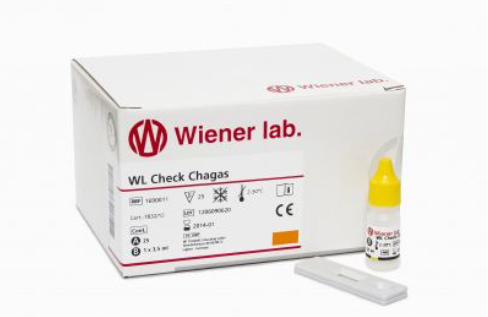-
WL Check Chagas (Professional)
Vendor:Wiener Laboratorios S.A.I.C.Regular price $0.00Regular priceUnit price per
FAQ
What is Chagas disease?
Chagas disease (CD), also known as American trypanosomiasis, is a neglected tropical disease (NTD) caused by the protozoan parasite Trypanosoma cruzi (T. cruzi) with a high morbimortality burden. As a potentially life-threatening illness, an estimated 30–40% of untreated infected individuals will develop severe medical problems over the course of their lives, including cardiac alterations, digestive manifestations, and neurological or associated alterations.
(The CUIDA Chagas Project- Andréa Silvestre de Sousa et al. Journal of
the Brazilian Society of Tropical Medicine. Vol.:55 | (e0171-2022) | 2022
What are the signs and symptoms of Chagas disease?
Chagas disease presents in 2 phases. The initial acute phase lasts for about 2 months
after infection. During the acute phase, a high number of parasites circulate in the blood, but in most cases symptoms are absent or mild and unspecific. In less than 50% of people bitten by a triatomine bug, characteristic first visible signs can be a skin lesion or a purplish swelling of the lids of one eye. Additionally, they can present fever, headache, enlarged lymph glands, pallor, muscle pain, difficulty in breathing, swelling, and abdominal or chest pain.
During the chronic phase, the parasites are hidden mainly in the heart and digestive
muscles. One to 3 decades later, up to a third of patients suffer from cardiac disorders and up to 1 in 10 suffer from digestive (typically enlargement of the oesophagus or colon), neurological or mixed alterations. In later years the infection in those patients can cause the destruction of the nervous system and heart muscle, consequent cardiac arrhythmias or progressive heart failure and sudden death.
(WHO 6 April 2023)
Why diagnose Chagas disease?
About 6–7 million people worldwide, mostly in Latin America, are estimated to be infected with Trypanosoma cruzi, the parasite that causes Chagas disease.
Despite the high morbidity and mortality and significant associated economic burden, only about 7% of people with CD have been diagnosed, and approximately 1% receive etiological treatment.
The WHO NTD road map includes 5 Chagas disease objectives:
- verification of the interruption of vectorial domiciliary transmission
- verification of interruption of transfusion transmission
- verification of the interruption of transmission by organ transplants
- elimination of congenital Chagas disease
- 75% coverage of antiparasitic treatment of the eligible population.
To attain the goal of elimination of Chagas disease transmission and provide health care for infected or people suffering from the disease both in endemic and non-endemic territories, WHO aims to increase networking at the global level and reinforce regional and national capacities.
(WHO 6 April 2023)

